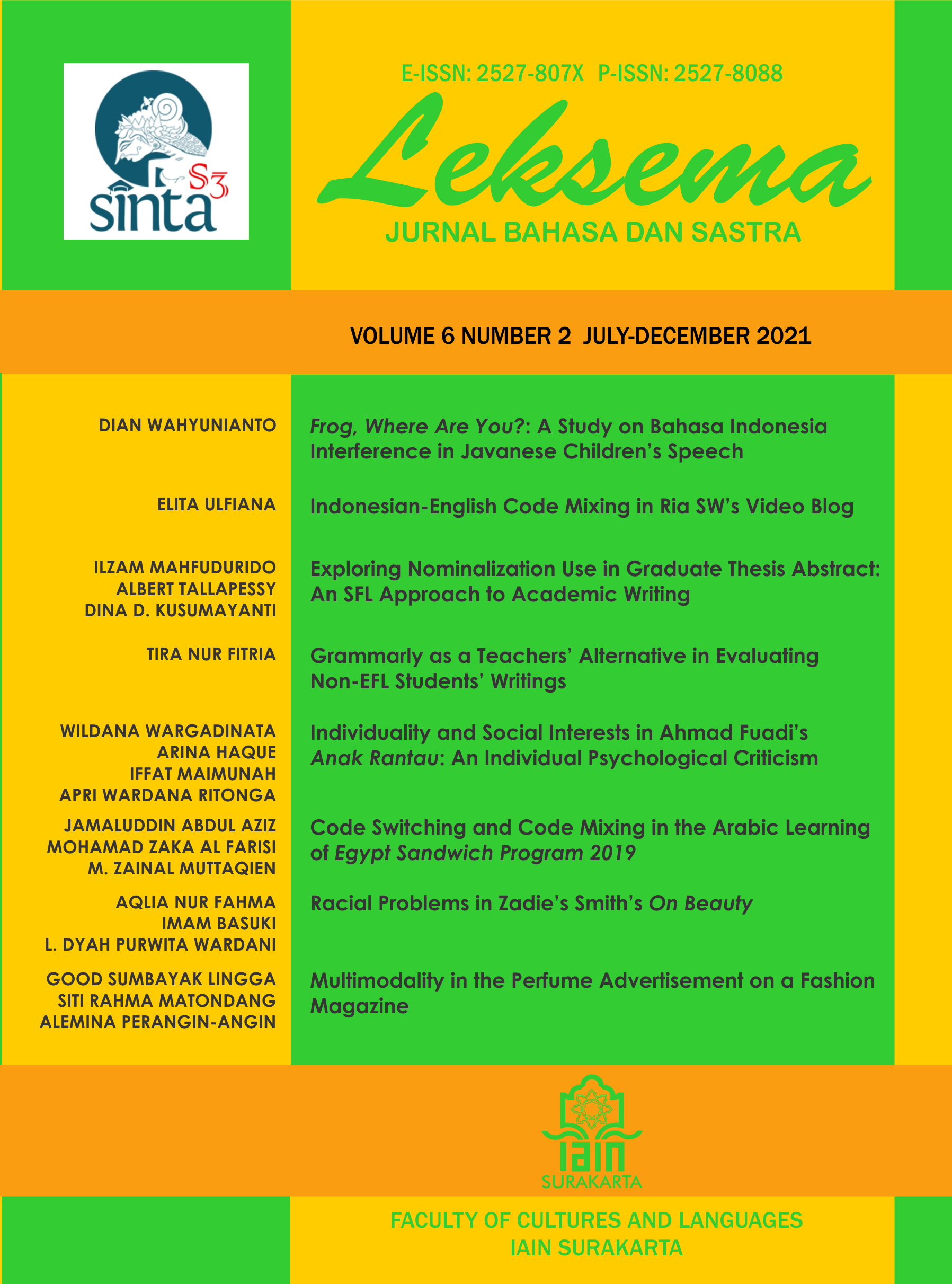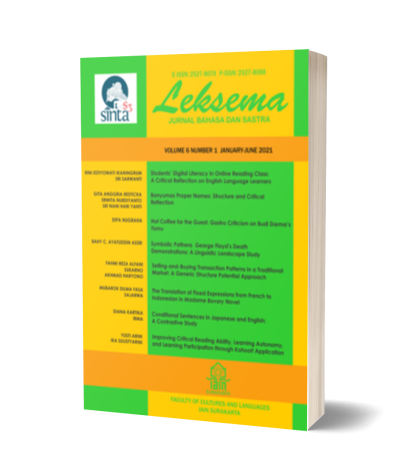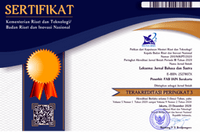RACIAL PROBLEMS IN ZADIE SMITH'S 'ON BEAUTY'
DOI:
https://doi.org/10.22515/ljbs.v6i2.4276Keywords:
individual racism, systemic racism, black, whiteAbstract
This paper discusses the problems of racism in the novel On Beauty. The analysis focuses on both individual and systemic racism represented in the novel as well as the critical position of the author. It employed Stuart Hall theory under qualitative method of analysis. The textual analysis was made to the narratives and dialogues in the novel which constitute racism in their meanings. It was concerned with how racism happens in the storyline. Meanwhile, the contextual analysis was carried out by using related references to supports the findings and the researchers’ arguments. The result showed that black women still accepted  negative stereotypes and became the objects of white people’s oppressions. They were mistreated despite the application of the law on equal protection for women and minorities. In 2000s, systemic racism continued and made it even harder for black people to get the same treatment as the whites. They suffered from the policies, particularly educational policies which had led to the increase of the poverty rate of black people.
Downloads
References
Anderson, Samuel. 2014. “Interracial Relationships: Stressors Among Races.†Social Work Master’s Clinical Research Papers: 1-58
Ansari, Sadiya. 2016. “Zadie Smith on Class, Race and Prince Harry’s New Relationshipâ€. Chatelaine (blog). November 15, 2016. https://www.chatelaine.com/living/books/ zadie-smith/
Apollon, Dominique. 2008. “Assessing Racial Injustice under the Bush Administrationâ€. Compact for Racial Justice. https://www.raceforward.org/sites/default/files/ ARC_compact_bush.pdf
Armitstead, Claire. 2019. “‘Identity Is a Pain in the Arse’: Zadie Smith on Political Correctnessâ€. The Guardian. February 2. http://www.theguardian.com/books/ 2019/feb/02/zadie-smith-political-correctness-hay-cartagena
Azizah, Giffana Fida. 2018. The Representation of Women Dominating Woman in Ayobami Adebayo’s Stay with Me (Undergraduate Thesis): Jember: Universitas Jember
Black, Simon. 2014. “Street Music, Urban Ethnography and Ghettoized Communities: Debates and Developments.†International Journal of Urban and Regional Research 38 (2): 700-705. https://doi.org/10.1111/1468-2427.12098
Child Trends. 2018. "Racial and Ethnic Composition of the Child Population". https://www.childtrends.org/indicators/racial-and-ethnic-composition-of-the-child-population
Clair, Matthew & Jeffrey S Denis. 2015. “Racism, Sociology ofâ€. In International Encyclopedia of the Social & Behavioral Sciences, 857-863. Elsevier. https://doi.org/10.1016/B978-0-08-097086-8.32122-5
Cox, Daniel, Juhem Navarro-Rivera & Robert P Jones. 2016. “Race, Religion, and Political Affiliation of Americans’ Core Social Networksâ€. PRRI (blog). 2016. https://www.prri.org/research/poll-race-religion-politics-americans-social-networks
“Definition of Ideologyâ€. 2021. Merriam-Webster Dictionary. https://www.merriam-webster.com/dictionary/ideology. Accessed September 25, 2021
Erikson, Erik H. 1950. Childhood and Society. Childhood and Society. New York: W W Norton & Co
“George W. Bush on Civil Rightsâ€. 2006. April 30. On The Issues. https://www.ontheissues.org/Celeb/ George_W__Bush_Civil_Rights.htm
Golash-Boza, Tanya. 2016. “A Critical and Comprehensive Sociological Theory of Race and Racismâ€. Sociology of Race and Ethnicity 2 (2): 129-41. https://doi.org/10.1177/2332649216632242
Grosfoguel, Ramon. 2016. “What Is Racism?â€. Journal of World-Systems Research 22 (1): 9-15. https://doi.org/10.5195/jwsr.2016.609
Hall, Stuart. 2020. “The Work of Representationâ€. In Tim Prentki & Nicola Abraham (eds.) The Applied Theatre Reader (Second Edition): 74–76. Abingdon: Routledge. https://doi.org/10.4324/9780429355363-15
Ho, Arnold K, Nour S Kteily & Jacqueline M Chen. 2017. “You’re One of Us: Black Americans’ Use of Hypodescent and Its Association with Egalitarianismâ€. Journal of Personality and Social Psychology 113 (5): 753–68. https://doi.org/10.1037/ pspi0000107
Irons, Meghan E. 2011. “Poverty Worsening in Hub, Study Saysâ€. Boston.com. November 9. http://archive.boston.com/news/local/massachusetts/articles/2011/11/09/poverty_concentrated_deepening_in_mattapan_dorchester_and_roxbury
JBHE. 2017. “George W. Bush, the NAACP, and the Persistent Damage to Black Higher Educationâ€. https://www.jbhe.com/features/51_specialreport.html
Kaba, Amadu Jacky. 2012. “Black Americans and Interracial Marriage: A Focus on Black Womenâ€. Sociology Mind 2 (4): 407–427. https://doi.org/10.4236/sm.2012.24054
Kim, Catherine. 2017. “Author Zadie Smith Discusses Race, Identity Expressed in Her Workâ€. The Daily Northwestern (blog). May 12. https://dailynorthwestern.com/2017/05/12/ campus/author-zadie-smith-discusses-race-identity-expressed-in-her-work
"Languages". 2007. Shorter Oxford English Dictionary (Sixth Edition). Oxford: Oxford University Press
Lewis, Jioni A, & Helen A Neville. 2015. “Construction and Initial Validation of the Gendered Racial Microaggressions Scale for Black Womenâ€. Journal of Counseling Psychology 62 (2): 289-302. https://doi.org/10.1037/cou0000062
Malcom, Shirley Mahaley, Paula Quick Hall & Janet Welsh Brown. 1976. “Others the Double Bind: The Price of Being a Minority Woman in Science." Conference of Minority Women Scientists. Washington DC: American Association for the Advancement of Science
Mulata, Mala. 2020. “Black Women and the Thin Line between Strong and Angryâ€. Medium. August 15. https://medium.com/age-of-awareness/black-women-and-the-thin-line-between-strong-and-angry-a999ae50d88e
“Multiracial Childrenâ€. 2016. American Academy of Child & Adolescent Psychiatry. https://www.aacap.org/AACAP/Families_and_Youth/Facts_for_Families/FFFGuide/ Multiracial-Children-071.aspx
Odenthal, Kathleen. 2019. “How Hip-Hop Music Has Influenced American Culture and Societyâ€. Spinditty. https://spinditty.com/genres/Hip-Hops-Influence-on-America.
“On Views of Race and Inequality, Blacks and Whites Are Worlds Apart.†2016. Pew Research Center’s Social & Demographic Trends Project. June 27. https://www.pewresearch.org/social-trends/2016/06/27/on-views-of-race-and-inequality-blacks-and-whites-are-worlds-apart
Pengerti, Calvian Nugroho. 2019. Racial Passing In American Racism In Sinclair Lewis’ Kingsblood Royal (Thesis). Jember: Fakultas Ilmu Budaya Universitas Jember. http://repository.unej.ac.id/handle/123456789/94159
President Bush Addresses NAACP Annual Convention. 2006. https://georgewbush-whitehouse.archives.gov/news/releases/2006/07/20060720.html
Rubel, Laurie & Andrea V McCloskey. 2019. The ‘Soft Bigotry of Low Expectations’ and Its Role in Maintaining White Supremacy through Mathematics Education 18
Smith, Zadie. 2005. On Beauty. 2005. https://www.goodreads.com/work/best_book/ 910752-on-beauty
Spates, Kamesha, Na’Tasha Evans, Tierra Akilah James & Karen Martinez. 2020. “Gendered Racism in the Lives of Black Women: A Qualitative Explorationâ€. Journal of Black Psychology 46 (8): 583-606. https://doi.org/10.1177/0095798420962257
Stone, Dana J & Megan Dolbin-MacNab. 2017. “Racial Socialization Practices of White Mothers Raising Black-White Biracial Children.†Contemporary Family Therapy 39 (2): 97-111. https://doi.org/10.1007/s10591-017-9406-1
Tatum, Beverly Daniel. 2019. “Together and Alone?: The Challenge of Talking about Racism on Campusâ€. Daedalus 148 (4): 79-93. https://doi.org/10.1162/daed_a_01761
Taylor, Keeanga-Yamahtta. 2003. "Racism". International Socialist Review 32. https://isreview.org/issues/32/racism.shtml
US Census Bureau Quick Facts: United States. 2019. https://www.census.gov/quickfacts/ fact/table/US/PST045219
Weaver, Jamie. 2020. “Identity Development in Biracial Children: Contextual Factors from Social Work†10
Downloads
Published
Issue
Section
License
Copyright (c) 2021 LEKSEMA: Jurnal Bahasa dan Sastra

This work is licensed under a Creative Commons Attribution-NonCommercial-ShareAlike 4.0 International License.
The copyright of the received article shall be assigned to the publisher of the journal. The intended copyright includes the right to publish the article in various forms (including reprints). The journal maintains the publishing rights to published articles.
In line with the license, the authors and users (readers or other researchers) are allowed to share and adapt the material only for non-commercial purposes. In addition, the material must be given appropriate credit, provided with a link to the license, and indicated if changes were made. If authors remix, transform or build upon the material, authors must distribute their contributions under the same license as the original.








